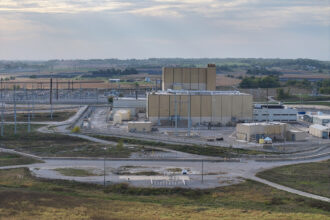In his “American Jobs Plan,” President Joe Biden aims to achieve unprecedented investment in action to address climate change by wrapping it in the kind of federal spending package that has allure for members of Congress of both parties.
The $2 trillion proposal holds out the promise of federal dollars for every Congressional district that has roads, bridges, water pipes, housing, transit systems, leaking oil wells or other infrastructure in need of upgrade and repair—in other words, most of the country. The only catch is that the money is meant for transformation, not restoration.
“This is no time to build back to the way things were,” said the preamble to the White House summary of the plan. “This is the moment to reimagine and rebuild a new economy.”
It remains to be seen whether in the current political climate, Biden will find any Republicans willing to sign on to an historic project to put the nation on track to a carbon-neutral economy, even if it means bringing money and jobs home to constituents. But it is well understood in Washington that Biden has a fallback option of passing much of the plan through a budget reconciliation measure, for which he wouldn’t need any GOP votes.
Biden’s proposal includes at least $650 billion in spending over 10 years on a U.S. clean energy transition; that would be about seven times the largest previous injection of federal money into clean energy, the $90 billion included in the economic stimulus package approved in the first year of President Barack Obama’s administration.
The final shape of the package will depend in large part on to what extent the Biden administration perceives it can negotiate to win bipartisan support, or to what extent it decides to move forward as aggressively and quickly as Democratic control of Congress will allow. House Speaker Nancy Pelosi said she wants to see a vote on legislation by July 4.
Here are nine key climate elements of Biden’s jobs and infrastructure plan:
- The largest single climate-related provision in the plan is $213 billion to build, modernize and weatherize affordable housing, an idea that melds Biden’s climate and economic justice goals. The plan would tackle homes and buildings, the source of 40 percent of all U.S. carbon emissions, while addressing the shortage of quality housing for low-income communities of color. Biden is calling on Congress to develop a new competitive grant program that would give state and local governments incentive to eliminate exclusionary zoning policies that have made it difficult for so many families to find affordable housing.
- Biden proposes spending $174 billion to accelerate a transition to electric vehicles in the United States through consumer incentives like tax credits to purchasers of EVs, the building of a network of 500,000 EV charging stations, and direct federal spending. For example, there would be federal funding for converting school buses to electric vehicles. And Biden proposes to use the federal procurement process to electrify the entire federal fleet of vehicles, including those of the U.S. Postal Service
- The proposal also includes $100 billion for power grid modernization and resilience, both intended to stave off catastrophic outages like the one that was blamed for 70 deaths in Texas in February, and to upgrade the system to better handle and transport wind and solar energy. The Biden plan would establish a new Grid Deployment Authority, with an aim of making better use of existing rights-of-ways along roads and railways to site new high-voltage transmission lines.
- Biden would make an historic $85 billion investment in modernizing public transit, support that mass transit systems would welcome after a year in which 65 percent had to cut service because of the drop in ridership and revenue resulting from the Covid-19 pandemic. That investment would come on top of the $30.5 billion that was in Biden’s Covid-19 relief bill to help mass transit systems, which typically get only $10 billion annually in federal funding. A key aim of the program is to bring bus, rapid transit and rail service to underserved communities and neighborhoods across the country.
This story is funded by readers like you.
Our nonprofit newsroom provides award-winning climate coverage free of charge and advertising. We rely on donations from readers like you to keep going. Please donate now to support our work.
Donate Now- The plan calls for a $35 billion investment in clean technology research and development, including the launching of a new incubator for cutting edge research. Biden proposes spending $15 billion in demonstration projects that will be key for tackling climate, like utility-scale energy storage, carbon capture and storage, hydrogen, advanced nuclear, rare earth element separations and floating offshore wind. Many of these areas of research already have bipartisan support.
- Biden would spend $16 billion employing union oil and gas workers to cap abandoned oil and gas wells and clean up mines, not only helping address unemployment in fossil fuel communities, but addressing emissions of the climate super-pollutant methane from the orphaned facilities.
- Biden’s package includes broad increases in corporate taxes, but he steered clear of including a carbon tax; though the idea has recently won support in the oil industry, neither Republicans nor Democrats on Capitol Hill have expressed enthusiasm for the idea. But Biden would fulfill his campaign pledge of eliminating fossil fuel industry subsidies, which are estimated to add up to at least $20 billion annually, including favored tax treatment for capital investments.
- Biden’s plan for the first time would establish a federal Energy Efficiency and Clean Electricity Standard requiring utilities to deliver a certain percentage of electricity from renewable or other clean energy sources. Although his plan did not spell out initial goals, Biden’s aim is to put the nation on track to a 100 percent carbon-pollution-free electricity sector by 2035.
- In the most direct nod to Franklin Delano Roosevelt’s New Deal, Biden would invest $10 billion in a new “Civilian Climate Corps.” In addition to conservation of public lands and waters projects, which was the focus of Roosevelt’s CCC, Biden’s Climate Corps would be deployed on projects to bolster community resilience and advance environmental justice.
Judy Fahys contributed reporting.
About This Story
Perhaps you noticed: This story, like all the news we publish, is free to read. That’s because Inside Climate News is a 501c3 nonprofit organization. We do not charge a subscription fee, lock our news behind a paywall, or clutter our website with ads. We make our news on climate and the environment freely available to you and anyone who wants it.
That’s not all. We also share our news for free with scores of other media organizations around the country. Many of them can’t afford to do environmental journalism of their own. We’ve built bureaus from coast to coast to report local stories, collaborate with local newsrooms and co-publish articles so that this vital work is shared as widely as possible.
Two of us launched ICN in 2007. Six years later we earned a Pulitzer Prize for National Reporting, and now we run the oldest and largest dedicated climate newsroom in the nation. We tell the story in all its complexity. We hold polluters accountable. We expose environmental injustice. We debunk misinformation. We scrutinize solutions and inspire action.
Donations from readers like you fund every aspect of what we do. If you don’t already, will you support our ongoing work, our reporting on the biggest crisis facing our planet, and help us reach even more readers in more places?
Please take a moment to make a tax-deductible donation. Every one of them makes a difference.
Thank you,













